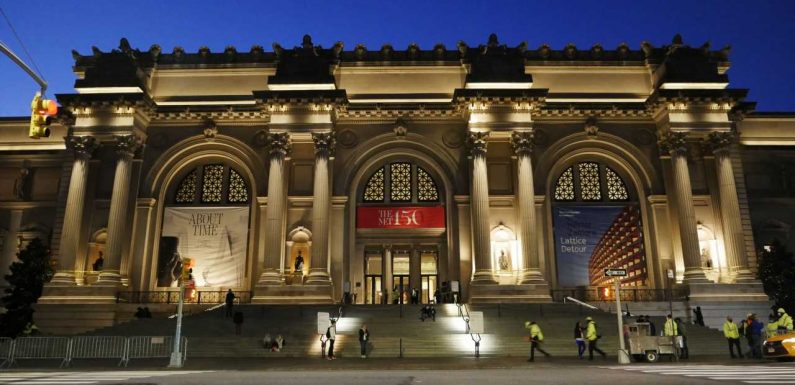
Five years in the making, the celebration of the 150th anniversary of the Metropolitan Museum of Art in New York did not go exactly as planned. Founded in 1870, the Met is the largest museum in the United States and one of the most preeminent in the world. But like every other institution, it was not prepared for the COVID-19 pandemic.
The impact of the pandemic, as well as the reckoning the museum faced in the wake of the death of George Floyd in May 2020—which forced it to reexamine its record on racial and social issues, and led to the adoption of policies to combat racism and support diversity and a stronger community—are the focus of the fascinating three-part documentary Inside the Met, premiering Friday night, May 21, on PBS. (The first two parts will debut on May 21 and the third on May 28.)
The first part, “The Birthday Surprise,” provides a behind-the-scenes look at preparations for the museum’s 150th anniversary celebration. Curators discuss planning for “Making the Met,” a major exhibition that traced the museum’s history, from its founding by New York City civic leaders, businessmen, philanthropists, art collectors, and artists, to what is called the current, “more nuanced approach to representing global visual culture as a web of intersecting narratives told through multiple voices.” Also featured are planning for the 2019 blockbuster Costume Institute exhibition, “Camp,” preparations for the reopening of the museum’s British galleries; and the unveiling of a series of sculptures by Kenyan artist Wangechi Mutu in previously empty niches on the museum’s façade. All efforts appear to be moving ahead as anticipated until the pandemic strikes, shutting the Met down for the first time in its 150-year history; it was closed from March 13 through August 26, 2020.
The documentary’s second part, “All Things to All People?”, explores how, in the summer of 2020, the museum begins to confront its past, exemplified, in part, by curators adding historical context to descriptions of works of art, to encourage dialogue and explore different points of view. A Jamaican-born Black woman from Connecticut visits the museum with her two young daughters; the three discuss their reactions to what they see. Puerto Rican visual artist Miguel Luciano and Toronto-based Cree artist Kent Monkman, whom the Met commissioned to create two huge paintings for its Great Hall that featured Monkman’s nonbinary alter ego, Miss Chief Eagle Testickle, also are interviewed.
“Love and Money,” the documentary’s third part, shows the museum reopening in a safe and limited way while facing a Covid-19 cash crisis. Planning for and construction of its newest Costume Institute exhibition, “About Time,” a highlight of the fall and winter season, are explored. Collectors Diane and Arthur Abbey, whose promised gift of more than 70 Japanese bamboo works was featured in a 2017 exhibition, are interviewed in their Fifth Avenue home, across from the museum. Legendary women’s couture collector Sandy Schreier is interviewed in her Michigan home, describing gifts of used clothing she received—which ultimately became the basis of her collection—from wealthy clients of her furrier father. Also featured are a young Californian of Vietnamese descent who is a new intern at the Cloisters, the Met’s medieval outpost in northern Manhattan, and a young couple on one of their first dates, who wander through the museum’s galleries and compare notes on the art they encounter.
English filmmaker Ian Denyer made the documentary for Oxford Film and Television on two visits, a 10-day stint in spring 2019, and a three-month stay in the late summer and fall of 2020. Originally the first part of the documentary was to focus on the business of running the Met, the second on what he calls its “new breed of curators,” and the third on its conservation and acquisition efforts. Denyer said he had to “tear up” these plans as a result of the pandemic, focusing instead on the museum’s “fight for survival.”
He filmed many people crying, including curators, as well as visitors to the museum immediately after it reopened, who weep for joy to be able to return to one of their favorite places. He called filming these individuals “deeply emotional” and said he found their reactions “very fitting.”
The museum gave Denyer free rein to film whatever interested him; it also had no say in the documentary’s editing process. Met president and chief executive Daniel H. Weiss said the museum was “not concerned” about what Denyer ultimately produced. “It was clear to us from the outset that Ian wanted to tell an honest story about the museum…. We didn’t want a propaganda film; that’s not worthy of an institution with scholarly ambition, any more than we would ask a curator to do their work that way.”
Denyer, he added, “had no bias…. He really brought a substantive understanding of our mission, respect for it, and great accomplishment as a filmmaker. We were very confident that he would find a story to tell that would be fair and honest and empathetic.”
Max Hollein, the museum’s director, said the documentary “really shows you an institution in all its complexities, all its human aspects. It shows that it’s a living organism, it is part of an overall understanding of who we are and where we are going.” The museum, he added, is “a microcosm for something much bigger, and that’s what we should be, because we are an institution about cultural development across ages and times.”
Source: Read Full Article









